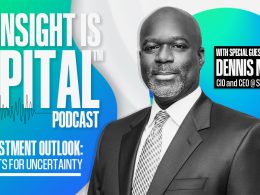by Roger Bayston, CFA, Franklin Templeton Investments
In today’s world of new technologies, it’s easy to grasp how digital innovations touch our personal lives. We can order groceries with a simple voice command, leave tips with our phone, or apply for online loans without leaving our couch. Less obvious are the ways data science and digital analytics have transformed the methods some asset managers use to analyse risks and generate returns.
The goal of risk analysis isn’t to avoid risks. On the contrary, generating positive returns over cash requires taking some risks. The chief job of a fixed income manager involves distinguishing which risks are more likely to pay off for investors versus those that probably won’t.
Using predictive algorithms—statistical modeling techniques that forecast outcomes—we can quickly analyse thousands of loans to spot ones that we believe offer better risk profiles.
Don’t Worry: Machines Are Watching You
Algorithms written in computer code are ever-present these days, predicting our behaviours. Some forecast how we’re likely to vote, while others anticipate our next purchase on websites like Amazon or Taobao in China. If you’ve used a credit card recently, it’s a certainty that computers are analysing all your transactions. Not necessarily to send you tailored marketing promotions, but for your protection.
Credit card companies like Visa and Mastercard use machine learning tools to stop fraudulent charges that you might otherwise be obligated to pay. By monitoring your charges, self-improving algorithms can pinpoint suspicious patterns much faster and cheaper than humans can.
Machines aren’t just analysing your spending or scrolling patterns, however. Advanced algorithms can also measure your creditworthiness—the likelihood you’ll pay back a loan—often with greater predictive accuracy than rudimentary credit scores like “SCHUFA” in Germany or “FICO” in the United States. These algorithms have given technology upstarts a leg up over traditional banks, many of whom still rely on one-dimensional credit scores. In emerging economies, these credit-scoring algorithms are a boon for millions of small businesses and consumers for whom brick-and-mortar banks are still out of reach.
A New Frontier: Digital Loans
Consider the fact that a large portion of Latin America’s population still lives without a bank account or credit cards, and largely gets by on cash. A big hurdle for cash-based entrepreneurs is that traditional banks won’t issue loans without a history of verified bank transactions. That’s where digitally sophisticated companies like MercadoLibre step into the picture.
MercadoLibre operates online marketplaces, much like eBay and Amazon, that serve 249 million customers throughout Latin America.1 By applying predictive algorithms to the vast quantities of data it collects from its online merchants and shoppers, MercadoLibre offers digital loans to consumers and budding entrepreneurs whom many local banks still largely ignore.
Digital loans are also widespread in China. Ant Financial—the financial technology division of China’s retailing giant Alibaba—has itself issued US$95 billion in consumer loans, largely by using big data and algorithms to measure consumer creditworthiness.2
In developed economies like the United States and United Kingdom, digital loans have grown rapidly over the past decade, partly in response to the financial crisis of 2007–2008. If traditional banks were reluctant to extend credit after the financial crisis, digital lenders were already primed to step in and pick up the slack. Zopa, which has the distinction of being the first online peer-to-peer lending service, was launched in 2005 in the United Kingdom.
In the United States, Prosper was founded in 2006 and LendingClub, which began as a Facebook application, launched in mid-2007. The US Treasury expects annual digital loan originations in the United States could reach US$90 billion by 2020.3
For borrowers, the key attraction of a company like LendingClub is the simplified, online application process and near-instant loan decision generated by algorithms in the cloud. We like LendingClub for two reasons: First, it generates a large quantity of digital loans—in 2018, LendingClub originated US$10.9 billion of loans.4
Second, asset managers can pick and choose the loans they think offer the best risk and return profile based on their own credit analysis.
By building a portfolio of digital loans one-by-one—the average LendingClub loan size is US$16,671—an asset manager can bypass some of the fees and constraints that come with pre-packaged securitised loans.5 However, for loans of this size, institutional asset managers need to utilise machines to analyse credit risks.
After sourcing and vetting borrowers through their websites, many marketplace lenders turn to banks which are licensed to “originate” the loans. They then sell the loans to investors like Franklin Templeton in the form of a “Note,” or in whole loan form. In the case of the former, the Note directs payments to institutional buyers based on the performance of the underlying loan. By purchasing these Notes, we agree to take on the borrower’s credit risk in exchange for interest and final principal payments.
So, how do we analyse the risk of borrower defaults across thousands of small consumer loans? Not with a large pool of human credit analysts, but by using a proprietary algorithm utilising hundreds of factors sourced from data in the cloud.
A Case Study: Seeing the Forest for the Trees
Using large data sets in the cloud, we’ve coded a type of algorithm that uses a random decision forest to go far beyond rudimentary credit scores, like FICO, which analyses metrics like loan payment history, total debt and types of credit. Combing thousands of social and economic variables (e.g., a borrower’s geographic region) across millions of observations, this proprietary algorithm forecasts likely defaults and expected returns with more granularity and speed than human analysts can process.
Individually, each data point may not have much predictive power—they are quite weak signals. It’s by combining seemingly unrelated signals that our algorithm can see the forest from the trees—measuring a borrower’s creditworthiness more accurately than FICO scores can.
The Promise and Pitfalls of Data Science
Given our data-abundant world, we know data science and machine learning tools can help us make smarter investment choices. However, we don’t think algorithms by themselves are a panacea for generating strong risk-adjusted returns. That’s particularly true for the fixed income markets we operate in. Purely quantitative bond strategies have had limited success compared with some factor-based equity approaches that pick stocks based on metrics like momentum or value.
We believe data science enhances our fixed income investment process, but it doesn’t replace the need for qualitative skills and the judgement of seasoned portfolio managers, fundamental research analysts and sector specialists. In our view, unaccompanied algorithms can have difficulty separating meaningful signals from noise. In some situations, they can point to false conclusions based on spurious correlations.
Consider the recent yield-curve hysteria. Albeit a non-algorithmic indicator, it’s gotten a lot of attention in the financial press. Some insist an inverted yield curve is a foolproof predictor of a recession. We don’t see it that way. We’ve examined the strength of the underlying economic data and based on our judgement, determined the yield curve is simply signaling a dovish US Federal Reserve and some panic in the markets.
In the end, we think predictive signals (algorithmic or otherwise) require specialised judgment that’s grounded in specific fixed income sectors, and an appreciation for shifting macro regimes. Machine learning is certainly a powerful ally, but it needs to be complemented by human experience.
Analysing Over a Million Home Loans Rapidly
Data science has broader applications beyond digital consumer loans. It’s also central, for example, to US agency mortgage-backed securities (MBS)—one of the world’s largest and most liquid fixed income markets after US Treasuries.
One quality global investors find attractive about Agency MBS is that the underlying home loans are backed by Fannie Mae and Freddie Mac—two US government-sponsored enterprises (GSEs). They effectively absorb the credit risks if underlying homeowners default on their loans.
In the wake of the 2008 financial crisis, the US government decided to transfer some MBS credit risks away from US taxpayers and into capital markets through credit risk transfer (CRT) securities. From their inception in 2013 through the end of 2018, CRTs have transferred credit risks on approximately US$2.8 trillion in single-family loans to institutional investors and away from the agencies themselves.6
Similar to unsecured digital loans, CRT investors receive a Note that delivers monthly payments, and principal can shrink if borrowers default on their loans. Unlike digital loans, however, CRTs are tied to mortgage pools that can contain 100,000 individual loans. CRT investors must accept the combined risks of the entire pool, or none at all.
Analysing credit risks across a large pool of mortgage loans is better suited to machines than human credit analysts. For starters, a speedy analysis is important since CRTs trade over-the-counter—a buyer may have a day, or even just one hour, to evaluate the risks before another buyer makes an offer. Data engineers regularly upload CRT datasets containing over a million mortgage loans with millions of rows of information. Then, proprietary algorithms can analyse a range of factors at the individual loan level in minutes instead of days, including expected home price appreciations, and prepayment and default risks as well as pricing and valuation.
The Art and Science of Managing Bond Portfolios
For digital loans, data science doesn’t just offer an enhanced method of risk analysis, it also helped create a new investable asset class. Integrating new methods of data science across multi-sector portfolios potentially can enhance outcomes for our clients. But the approach still requires the judgement of portfolio managers, who can blend macro views across shifting regimes, with bottom-up insights gleaned from years of experience in specific sectors like MBS. Predictive algorithms don’t offer a panacea, but in our view they are the next phase in advanced asset management.
To get insights from Franklin Templeton delivered to your inbox, subscribe to the Beyond Bulls & Bears blog.
For timely investing tidbits, follow us on Twitter @FTI_Global and on LinkedIn.
Important Legal Information
This material is intended to be of general interest only and should not be construed as individual investment advice or a recommendation or solicitation to buy, sell or hold any security or to adopt any investment strategy. It does not constitute legal or tax advice.
The companies and case studies shown herein are used solely for illustrative purposes; any investment may or may not be currently held by any portfolio advised by Franklin Templeton Investments. The opinions are intended solely to provide insight into how securities are analysed. The information provided is not a recommendation or individual investment advice for any particular security, strategy, or investment product and is not an indication of the trading intent of any Franklin Templeton managed portfolio. This is not a complete analysis of every material fact regarding any industry, security or investment and should not be viewed as an investment recommendation. This is intended to provide insight into the portfolio selection and research process. Factual statements are taken from sources considered reliable, but have not been independently verified for completeness or accuracy. These opinions may not be relied upon as investment advice or as an offer for any particular security. Past performance does not guarantee future results.
The views expressed are those of the investment manager and the comments, opinions and analyses are rendered as of 4 September 2019 and may change without notice. The information provided in this material is not intended as a complete analysis of every material fact regarding any country, region or market.
Data from third party sources may have been used in the preparation of this material and Franklin Templeton Investments (“FTI”) has not independently verified, validated or audited such data. FTI accepts no liability whatsoever for any loss arising from use of this information and reliance upon the comments opinions and analyses in the material is at the sole discretion of the user.
Products, services and information may not be available in all jurisdictions and are offered outside the US by other FTI affiliates and/or their distributors as local laws and regulation permits. Please consult your own professional adviser or Franklin Templeton institutional contact for further information on availability of products and services in your jurisdiction.
CFA® and Chartered Financial Analyst® are trademarks owned by CFA Institute.
What Are the Risks?
All investments involve risks, including possible loss of principal. The value of investments can go down as well as up, and investors may not get back the full amount invested. Bond prices generally move in the opposite direction of interest rates. The price and yield of a MBS will be affected by interest rate movements and mortgage prepayments. During periods of declining interest rates, principal prepayments tend to increase as borrowers refinance their mortgages at lower rates; therefore MBS investors may be forced to reinvest returned principal at lower interest rates, reducing income. A MBS may be affected by borrowers that fail to make interest payments and repay principal when due. Changes in the financial strength of a MBS or in a MBS’s credit rating may affect its value. Special risks are associated with foreign investing, including currency fluctuations, economic instability and political developments. Investments in emerging markets involve heightened risks related to the same factors, in addition to those associated with these markets’ smaller size and lesser liquidity. Investments in fast-growing industries like the technology sector (which historically has been volatile) could result in increased price fluctuation, especially over the short term, due to the rapid pace of product change and development and changes in government regulation of companies emphasizing scientific or technological advancement.
___________________________________
1. Source: MercadoLibre FactSet consensus estimate 2018. See www.franklintempletondatasources.com for additional data provider information.
2. Source: Kwan, A. “Ant Financial Consumer Lending Reached $95 Billion,” Bloomberg News, 12 March 2018.
3. Source: US Department of the Treasury, “Opportunities and Challenges in Online Marketplace Lending,” 10 May 2016.
4. Source: LendingClub full year financial statement for 2018.
5. Source: Porter, K. “LendingClub Personal Loans: 2019 Comprehensive Review,” Bankrate, 7 August 2019.
6. Source: US Federal Housing Finance Agency, “Credit Risk Transfer Progress Report,” Fourth quarter 2018.
This post was first published at the official blog of Franklin Templeton Investments.
















